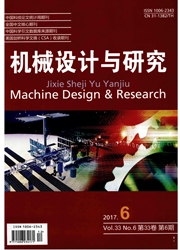

 中文摘要:
中文摘要:
大型天线支撑结构的合理设计对满足系统刚强度、轴系精度具有十分重要的意义。基于变密度法的拓扑优化方法根据约束条件和目标函数确定结构内材料最优分布,是合理进行支撑结构内部加强筋设计的一种行之有效方法。推导了以位移为约束,结构质量为优化目标变密度拓扑优化模型;针对某大型天线系统的支撑结构原设计方案中质量较大、结构内加强筋设计不合理出现局部应力集中等问题,设计该结构的三维拓扑优化域,运用该模型以天线系统允许的最小变形为约束条件,以质量最轻为目标进行三维支撑结构的拓扑优化设计,结合栽荷传递路径,提出大型天线系统支撑结构内部加强筋设计方案,并采用尺寸优化方法对支撑结构外表面的上支架、底座等位置的板筋厚度进行优化,确定了支撑结构的最终优化方案。经验证,该结构在原方案的基础上减重12.5%,且有效地改善了力传递特性,消除了应力集中现象。
 英文摘要:
英文摘要:
Supporting Structure is a crucial part of large antenna system in fulfilling stiffness, strength and accura- cy requirements. Topology optimization method based on SIMP (Solid Isotropic Material with Penalization) is an effective approach to determine optimal material layout under given constraint and objective function; it also gives practical guidance in designing the layout of sheets inside supporting structure. Aiming at problems of overweight and stress con- centration in original design, a topology optimization problem is built whose design domain is the internal space of supporting structure, whose constraint is the maximum permissible displacement in Y direction and whose objective is to minimize the mass of supporting structure. Based on the result of computation and load pass of antenna system, a new design of sheet layout is given and based on the new design a size optimization approach is used in determine the specific dimensions of external shell and internal sheet of supporting structure. The result of numerical test shows that the news design reduces 12.5% mass compared with original design and also eliminates stress concentration.
 同期刊论文项目
同期刊论文项目
 同项目期刊论文
同项目期刊论文
 期刊信息
期刊信息
